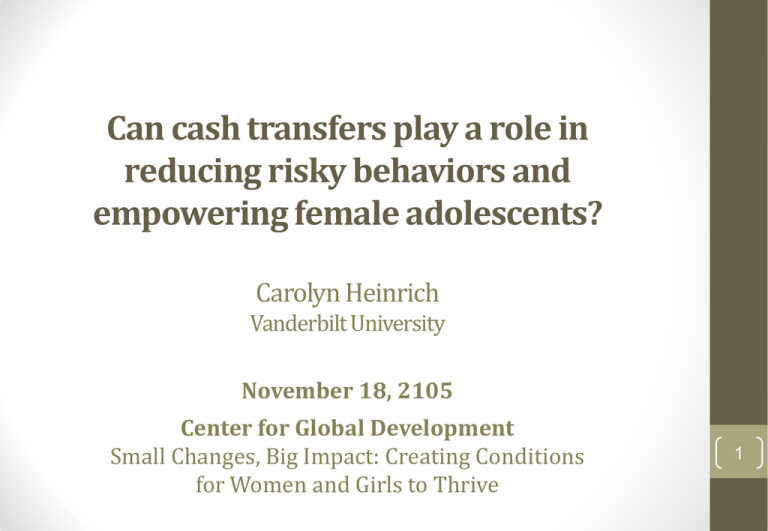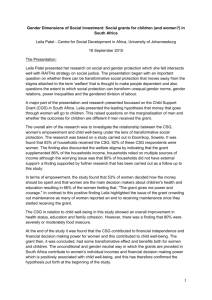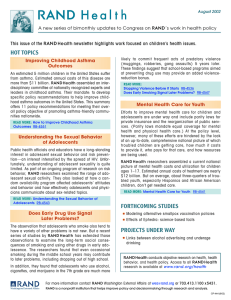Can cash transfers play a role in reducing risky behaviors and
advertisement

Can cash transfers play a role in reducing risky behaviors and empowering female adolescents? Carolyn Heinrich Vanderbilt University November 18, 2105 Center for Global Development Small Changes, Big Impact: Creating Conditions for Women and Girls to Thrive 1 Theory/evidence on role for cash transfers in reducing risky behaviors • Perceptions of lack of economic opportunity, powerlessness in poverty lead youth to heavily discount costs of risky behavior (Medlin and de Walque, 2008) • Direct cash transfers can offer a substitute (immediate cash benefits) or incentive (reward for declining risks) that alters adolescent valuations of benefits and costs • Growing evidence that risky behaviors vary with household consumption and income shocks • Increases in household income protect females from early sexual debut, risky sex and pregnancy (Dinkelman et al., 2008; Baird et al., 2011; Kohler and Thorton, 2012); reduce risk of HIV infections in adolescents (Baird et al., 2012; Pettifor, 2012) 2 “State of emergency” for South African and other sub-Saharan African adolescents • Adolescents living in poverty at significant risk for negative outcomes associated with risky behaviors (e.g., early sexual activity, alcohol and drug use) • Young people (15-25 years) at greatest risk of HIV; in S. Africa, 10% HIV prevalence rate in population, with highest rates for females ages 18-24 years: 20.8% (Pettifor et al., 2011) • Alcohol use consistently associated with sexual risk taking, sexual coercion and elevated risk of HIV • Poverty increases female youth involvement in transactional and intergenerational sex • Substantial negative consequences associated with early sexual debut 3 What role can cash transfers play? South Africa’s Child Support Grant • Social cash transfer program introduced in 1998 • Means-tested benefit; caregiver applies on behalf of child • Early take-up slower, with many program changes: • Age of eligibility extended: in 2003 (to 8 years), 2004 (to 10 years), 2005 (to under 14), 2009 (to under 15); 2010 (to under 16), to under 17 in 2011 and under 18 years in 2012 • Unconditional cash transfer, but Dec. 2009 amendments added “soft” caregiver obligations to enroll children in school • 69% of households responded that proof of school attendance for school-age children was required in CSG application 4 DSD-EPRI-IDS-IFPRI-OPM-RDC-TNT impact evaluation of CSG • Integrated qualitative-quantitative study of program process, mechanisms of change, and impacts • Variability in timing and length of CSG enrolment used to analyze impacts associated with differing CSG dosages • Impacts on health, education, early child development, adult/child labor, consumption, social welfare, risky behavior, intra-household, unintended impacts • Sample: adolescents between ages 15 and 17 years • Early vs. late enrolment ( & only recently able to enrol) • 5 provinces: Eastern Cape, Gauteng, KwaZulu-Natal, Limpopo, and the Western Cape 5 Household and adolescent reports of how the cash transfer is spent • 90% of households report that the CSG is spent on the eligible child, although about one-third believe the grant should benefit the whole family • Top reported expenditure is consumption (76%), followed by schooling/education-related expenses (17%) • 69% of female adolescents are given some CSG “pocket money” to spend (about 1/3 of CSG benefit amount) • 82% of female adolescents report spending their pocket money on food, and another 5% on drinks or sweets • Less than 5% spent cash on beauty supplies (hair, cosmetics) 6 Outcomes of interest and sample averages Female adolescent outcomes Never had sex Never used drugs Never drank alcohol Age at first alcohol use† No criminal activity†† No gang activity Number of sex partners Ever pregnant Highest grade attained †Lower 371 422 432 386 394 390 346 282 465 0.906 0.791 0.704 0.777 0.766 0.964 0.234 0.067 9.241 Max=6 value=lower age at first alcohol use;†† criminal activity includes stealing, “housebreaking,” rape or sexual assault, selling drugs, assault 7 Relationship between months of cash transfers and female abstinence from sexual activity 1 .8 .6 Never had sex 1.2 Dose Response Function 0 50 100 150 Number of months received the CSG Dose Response Low bound Upper bound Confidence Bounds at .95 % level Dose response function = Probability of a positive outcome Regression command = logit 8 Relationship between months of cash transfers and number of sex partners .2 0 -.2 -.4 -.6 Number of sexual partners .4 Dose response: CSG dosage and number of sexual partners, females 0 50 100 150 Months of cash transfers (CSG) received Dose Response Upper bound Confidence Bounds at .95 % level Dose response function = Linear prediction Low bound 9 Impacts larger with CSG receipt in adolescence Effects of Receiving the CSG in Adolescence on Adolescent Risky Behaviors Exact matching on CSG dose Outcome (females) Never had sex Number of sex partners Ever pregnant Never drank alcohol Never used drugs Ever sold drugs Treatment: adolescents received CSG in adolescence Difference (ATE) 0.111 -0.337 -0.105 0.049 0.039 -0.021 Results from propensity score matching Standard error 0.043 0.136 0.043 0.054 0.050 0.026 p-value 0.010 0.013 0.014 0.366 0.447 0.403 10 0 .005 Density .01 .015 .02 .025 Actual vs. Intended Child Support Grant Dose 0 50 Intended dose 100 150 Actual dose 11 Impacts larger if CSG receipt was never interrupted Female adolescents exact matched on intended dose Outcome Never had sex Number of sex partners Ever pregnant Never drank alcohol Age at first alcohol use Never used drugs No criminal activity Highest grade completed Never interrupted Difference (ATE) 0.055 -0.235 -0.046 0.017 0.099 0.009 0.134 0.197 Standard error 0.030 0.090 0.030 0.048 0.195 0.044 0.045 0.102 p-value 0.071 0.009 0.129 0.720 0.612 0.830 0.003 0.054 12 Implications for gender equality and women’s empowerment • Early cash transfer receipt and receipt during teenage years are particularly important in protecting female adolescents against early sexual debut and in reducing number of sexual partners and early pregnancy • Survey responses and qualitative research suggest that cash transfers empower female adolescents to make their own consumption decisions and reduces their dependence on older boyfriends and the draw of transactional sex • Delay of sexual activity and pregnancy could have longerterm effects in empowering women and promoting gender equality 13 Findings and implications (cont.) • Increase in educational attainment and greater protective effects against risky behavior when cash transfer receipt is not interrupted or stopped early • Youth in poorer areas less likely to be reached at an early age and to stay connected with transfers in teenage years • Findings support policy changes to extend cash transfers to older children, to reach them at earlier ages and to improve program administration and outreach and simplify application processes to fully realize the potential benefits of cash transfers in supporting the education and empowerment of women • Hard conditions or targeting of particular behaviors not necessary to generate effects 14






